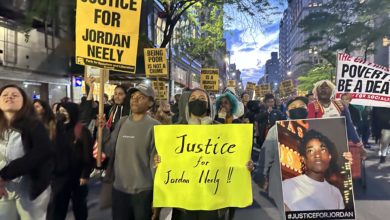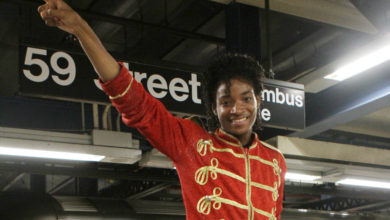
In the month of October, many events took place that brought national attention to the unfinished struggle of African-American people. The Millions More Movement, which was initially called to mark the ten-year anniversary of the Million Man March, brought hundreds of thousands of African Americans to the National Mall. Most came to air grievances regarding the criminally inadequate government response to Hurricane Katrina, the crippling poverty that continues to plague the Black community and the continued war in Iraq.
The death of Rosa Parks highlighted the importance of the civil rights movement of the 1950s and 60s, and the incredible leadership and sacrifice that she and many others gave to achieve the gains made in the last three decades. The fightback response of Black youth in Toledo to a rally by the Ku Klux Klan showed the spirit of resistance surfacing spontaneously in response to racism and repression.
The Millions More Movement was widely attended. There was a great range and diversity in the leadership of the demonstration. Called by the Nation of Islam, the demonstration was also co-convened by Black leaders such as Jesse Jackson, Dr. Dorothy Height, Russell Simmons and Al Sharpton. This showed a far-reaching consensus amongst the leadership of the Black community that there is a need for systemic change in the United States, particularly as it pertains to policies that shape the lives of African Americans. Other African American community leaders from all over the United States brought youth, church and political organizations to Washington D.C., for this event. The wide range of participation from the Black community reflected the yearning of African Americans for change.
Speakers at the march denounced the Bush administration’s racist policies, the prison system, police brutality, the failing educational system, the dire need for health care and many other issues that affect the Black community, including the war in Iraq.
Rosa Parks and the need for organization
This same type of desire for unity in the face of the U.S. government’s failure to address the inequality and racism plaguing African Americans sparked the historic civil rights movement of which Rosa Parks was a key figure. Parks’ death on Oct. 24 prompted even the most backward and racist of politicians to give lip service to her historic contributions.
All of the praise given to Parks was deserved. But the condolences and recognition of her assistance to the Black community that came from the Bush administration and others in the U.S. government rang hollow.
Lenin’s summation of the ruling class’s response to great revolutionaries in the opening paragraphs of “State and Revolution” still applies today. “During the lifetime of great revolutionaries, the oppressing classes constantly hounded them, received their theories with the most savage malice, the most furious hatred and the most unscrupulous campaigns of lies and slander. After their death, attempts are made to convert them into harmless icons, to canonize them, so to say, and to hallow their names to a certain extent for the ‘consolation’ of the oppressed classes and with the object of duping the latter.”
The U.S. government has made attempts to distort the actions of Rosa Parks and the entire history of the civil rights movement. The mythology surrounding her historic refusal to give up her seat, a move that sparked the Montgomery Bus Boycott, presents her actions as spontaneous. Parks is portrayed as a larger-than-life figure who acted alone.
In reality, Parks had been working for the Montgomery NAACP for 12 years prior to her actions on the bus. She also trained and worked closely with other civil rights leaders beforehand. Her decision was most likely influenced by the success of other similar bus-boycott campaigns in Baton Rouge and one in Montgomery 50 years earlier that won some limited gains.
The previous spring, another young woman had refused to give up her bus seat in Montgomery, a case that the NAACP almost used for the campaign. Upon discovery of the young woman’s pregnancy and because she was unmarried, they decided not to use that case, possibly fearing a debate would ensue over her character and cloud the issue.
Parks was a true activist. However, the important role of the organization and movement that supported her cannot be understated. Without the support of an entire organization, her contribution would not have been as effective. It was the NAACP organization that helped spread the relevancy of her defiance far beyond the city limits of Montgomery, Alabama.
The struggle continues
Significant gains were made by the civil rights movement. This powerful, organized rebellion of African Americans and their alliance with other nationalities that fought beside them led to a profound shift in the United States. It effectively ended legal apartheid and allowed for the improvement of living conditions for many in the Black community. While this is true, the struggle clearly is not over. In some respects, the oppression of the Black nation in the United States is as great, if not greater, today. Between 1991 and 2000, nearly 1 million Black people died due to a lack of adequate health care, according to an article in the Washington Post, Dec. 21, 2004. Eighty-five percent of African Americans will use food stamps at some point in their lifetime found Thomas A. Hirschl, professor of development sociology at Cornell, who conducted a study on food stamp use (“Half Of Americans Will Use Food Stamps”, KOCO 5 Oklahoma City, ChannelOklahoma.com, August 25, 2004).
An Oct. 17, Miami Herald article referenced a report released by the Advancement Project that shows that “[B]lack students are disproportionately suspended, expelled and arrested in comparison to white classmates.”
The current capitalist system has drastically eroded the living conditions for U.S. workers. Its impact on African American workers and Black communities is especially severe. This has sparked a spirit of resistance among the entire Black population.
The spirit of resistance will continue until Black people win real equality and liberation. It was evident in the militant reaction of Black youth in Toledo, Ohio, to the presence of the Ku Klux Klan in their neighborhood and the compliance of the police, who supported the Klan’s right to be present.
The Millions More Movement March showed the vast potential for advancing the Black national liberation struggle in the United States. That struggle, combined with the growing movements against war, cutbacks and economic crisis, promises to present the U.S. capitalist class with its greatest threat in decades.
Hundreds of thousands traveled to Washington, D.C. for the Oct. 15 Millions More Movement.
Photo: Reuters/Joshua Roberts





